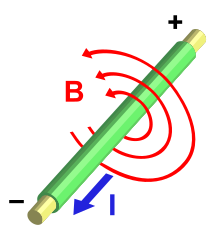Ampère's circuital law: Difference between revisions
No edit summary |
Why did you undo the corrections? Displacement current was not conceived in conjunction with a capacitor circuit |
||
| Line 1: | Line 1: | ||
{{electromagnetism}} |
{{electromagnetism}} |
||
When is somebody going to correct the title of this page to Ampère's Circuital law? Ampère's law is a different law altogether and it concerns the force between two electric current elements. |
|||
| ⚫ | |||
| ⚫ | |||
| ⚫ | |||
| ⚫ | |||
[[Image:Electromagnetism.svg|thumb|left|An electric current produces a magnetic field.]] |
[[Image:Electromagnetism.svg|thumb|left|An electric current produces a magnetic field.]] |
||
In its original form, Ampère's law relates the magnetic field <math>\vec{H}</math> to its source, the current density <math>\vec{J}</math>: |
In its original form, Ampère's Circuital law relates the magnetic field <math>\vec{H}</math> to its source, the current density <math>\vec{J}</math>: |
||
:<math>\oint_C \vec{H} \cdot \mathrm{d}\vec{l} = \int\!\!\!\!\int_S \vec{J} \cdot \mathrm{d}\vec{S} = I_{\mathrm{enc}} </math> |
:<math>\oint_C \vec{H} \cdot \mathrm{d}\vec{l} = \int\!\!\!\!\int_S \vec{J} \cdot \mathrm{d}\vec{S} = I_{\mathrm{enc}} </math> |
||
| Line 28: | Line 30: | ||
where <math>\mu \!\ </math> is the [[Permeability (electromagnetism)|permeability]] of the medium (in [[henries]] per meter), which by definition is <math>4 \pi \times 10^{-7}</math> in free space. In non-linear media, <math>\mu \!\ </math> is a rank-2 tensor. |
where <math>\mu \!\ </math> is the [[Permeability (electromagnetism)|permeability]] of the medium (in [[henries]] per meter), which by definition is <math>4 \pi \times 10^{-7}</math> in free space. In non-linear media, <math>\mu \!\ </math> is a rank-2 tensor. |
||
==Corrected Ampère's law: the Ampère-Maxwell equation== |
==Corrected Ampère's Circuital law: the Ampère-Maxwell equation== |
||
[[James Clerk Maxwell]] conceived of [[displacement current]] as a polarization current in the dielectric vortex sea which he used to model the magnetic field hydrodynamically and mechanically. He added this [[displacement current]] to Ampère's Circuital law at equation (112) in his 1861 paper [http://vacuum-physics.com/Maxwell/maxwell_oplf.pdf On Physical Lines of Force]. |
|||
[[James Clerk Maxwell]] noticed a logical inconsistency when applying Ampère's law to a charging or discharging [[capacitor]]. If surface <math>S</math> passes between the plates of the capacitor, and not through any wires, then <math>\vec{J} = 0</math> even though <math>\oint_C \vec{H} \cdot \mathrm{d}\vec{l}\ne 0</math>. He concluded that this law had to be incomplete. To resolve the problem, he came up with the concept of [[displacement current]] and made a generalized version of Ampère's law which was incorporated into [[Maxwell's equations]]. |
|||
The generalized law, as corrected by Maxwell, takes the following integral form: |
The generalized law, as corrected by Maxwell, takes the following integral form: |
||
Revision as of 06:00, 14 April 2007
| Articles about |
| Electromagnetism |
|---|
 |
When is somebody going to correct the title of this page to Ampère's Circuital law? Ampère's law is a different law altogether and it concerns the force between two electric current elements.
In physics, Ampère's Circuital law, discovered by André-Marie Ampère, relates the circulating magnetic field in a closed loop to the electric current passing through the loop. It is the magnetic equivalent of Faraday's law of induction.
Original Ampère's Circuital law

In its original form, Ampère's Circuital law relates the magnetic field to its source, the current density :
where
- is the closed line integral around contour (closed curve) C.
- is the magnetic field in amperes per metre.
- is an infinitesimal element (differential) of the contour C,
- is the current density (in amperes per square meter) through the surface S enclosed by contour C
- is a differential vector area element of surface S, with infinitesimally small magnitude and direction normal to surface S,
- is the current enclosed by the curve C, or strictly, the current that penetrates surface S.
Equivalently, the original equation in differential form is
where
- is the curl operator.
The magnetic field in linear media, is related to the magnetic flux density (in teslas) by
where is the permeability of the medium (in henries per meter), which by definition is in free space. In non-linear media, is a rank-2 tensor.
Corrected Ampère's Circuital law: the Ampère-Maxwell equation
James Clerk Maxwell conceived of displacement current as a polarization current in the dielectric vortex sea which he used to model the magnetic field hydrodynamically and mechanically. He added this displacement current to Ampère's Circuital law at equation (112) in his 1861 paper On Physical Lines of Force.
The generalized law, as corrected by Maxwell, takes the following integral form:
where in linear media
is the displacement flux density (in coulombs per square meter).
This Ampère-Maxwell law can also be stated in differential form:
where the second term arises from the displacement current.
With the addition of the displacement current, Maxwell was able to postulate (correctly) that light was a form of electromagnetic wave. See Electromagnetic wave equation for a discussion on this important discovery.
See also
- Maxwell's equations
- Biot-Savart law
- Faraday's law of induction
- Gauss's law
- Electric current
- Vector calculus
- Stokes' theorem
References
- Griffiths, David J. (1998). Introduction to Electrodynamics (3rd ed.). Prentice Hall. ISBN 013805326X.
- Tipler, Paul (2004). Physics for Scientists and Engineers: Electricity, Magnetism, Light, and Elementary Modern Physics (5th ed.). W. H. Freeman. ISBN 0716708108.
External links
- a section on Ampere's law from an online textbook
- MISN-0-138 Ampere's Law (PDF file) by Kirby Morgan for Project PHYSNET.
- MISN-0-145 The Ampere-Maxwell Equation; Displacement Current (PDF file) by J.S. Kovacs for Project PHYSNET.
- The Ampère's Law Song (PDF file) by Walter Fox Smith; Main page, with recordings of the song.
















